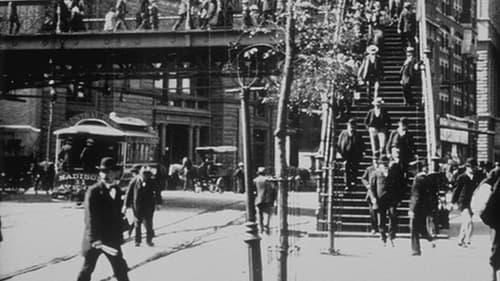Color Sequence (1943)
Genre : Animation
Runtime : 2M
Director : Dwinell Grant
Synopsis
One of Grant's most interesting and important films is Color Sequence (1943) which consists only of pure solid-colour frames that fade, mutate and flicker. He made the film as a research into colour rhythms and perceptual phenomena, and although it now appears not only visually exciting but also as a precedent for the work of younger film-makers like Paul Sharits, Grant himself found the film to be too disquieting when it was first screened (cf. the Film Exercises), and it received little further play until the 70s.

Our presidential hunter runs across the landscape and falls down in the snow, gets up with his rifle, and gazes upward at a treed animal which isn't in the camera's view. He fires a shot into the tree, then leaps on the ground to grab the fallen prey, a domestic cat, finishing it off with wild blows of his hunting knife while his companions, a photographer and a press agent, record the event that will be reported far and wide as a manly moment. Teddy then rides out of the forest followed by two companions afoot, never mind that they all originally arrived afoot. Perhaps it was funnier in its day than it is now, but apparently shooting cats was regarded as funny in those days. The larger point was to use a minor whimsy as a political criticism, in this case of Teddy Roosevelt's easy manipulations of the press. It was based on two frames of a political cartoon that had appeared in the paper a mere week before the film was made.

A man is drinking wine, pukes it up, and eats it. He repeats it for a while, until he starts to rub the vomit all over himself.

Footage of a bullfight, shot by Hill in 1934, hand-painted by the artist three decades later.

A political satire in which an animated man with a drum is waiting for his cue.

A short experimental anime about a woman desperately in love. Made by Yoji Kuri, a well-known Japanese indie animator.

Live-action footage of canaries and beachgoers overlaid with hand-painted effects.

When a housewife's girlfriends take her to a male strip club for her birthday, she brings back more than memories.

An animated short film created by the artist Jeff Scher.

This two-color (green-blue and red) film was produced as a demonstration reel at the Paragon Studios in Fort Lee, New Jersey, under the direction of Kodak scientist John Capstaff. It features leading actresses, including Mae Murray, Hope Hampton, and Mary Eaton, posing and miming for the camera to showcase the capability of the complex Kodachrome process to capture their translucent movie star complexions and colorful, high-fashion clothing. (loc.gov)

New York, travelers descent of the Brooklyn Bridge

This scene is a part of the very first film shot produced by the Manaki Brothers. Despina, the Janaki and Milton Manaki's grandmother, was recorded weaving in one high-angle shot. For no apparent reason, the first shot made in Macedonia, in the Balkans in fact, made by these two cinematography pioneers, contains peculiar symbolics: at the moment when the grandmother Despina spins the weaving wheel, film starts rolling in our country.

'Associations' sets language against itself by using the ambiguities inherent in the English language. Images from magazines and color supplements accompany a voice-over reading from the book 'Word Associations and Linguistic Theory' by academic linguistic Herbert H. Clark. Combining a wry sense of humor with word/visual games and puns, Smith explores the boundaries of cinematic montage by combining elements together and against each other in order to destroy and create multiple meanings at the same time.

Stan Brakhage's final film, made shortly before his death by wetting a filmstrip with saliva and using his fingernail to scratch marks into the emulsion.

Intended as a publicity film for Chrysler, Rhythm uses rapid editing to speed up the assembly of a car, synchronizing it to African drum music. The sponsor was horrified by the music and suspicious of the way a worker was shown winking at the camera; although Rhythm won first prize at a New York advertising festival, it was disqualified because Chrysler had never given it a television screening. P. Adams Sitney wrote, “Although his reputation has been sustained by the invention of direct painting on film, Lye deserves equal credit as one of the great masters of montage.” And in Film Culture, Jonas Mekas said to Peter Kubelka, “Have you seen Len Lye’s 50-second automobile commercial? Nothing happens there…except that it’s filled with some kind of secret action of cinema.” - Harvard Film Archive

Dark, fast-paced symmetry in mixed weave of tones moving from oranges & yellows to blue-greens, then retreating (dissolves of zooming away) to both rounded and soft-edged shapes shot with black.

Multiple thrusts and then retractions of oranges, reds, blues, and the flickering, almost black, textural dissolves suggesting an amalgam approaching script.

Experimental film showing film clips of a garden, with birds chirping for the soundtrack.

Scratch and Crow is a student film by Helen Hill made at the California Institute of the Arts. It is filled with vivid color and a light sense of humor. It is also a poetic and spiritual homage to animals and the human soul

A short film where circus performers entertain children.

This hand-painted and elaborately step-printed work begins with a flourish of reds and yellows and purples in palpable fruit-like shapes interspersed by darkness, then becomes lit lightning-like by sharp multiply-colored twigs-of shape, all resolving into shapes of decay.




